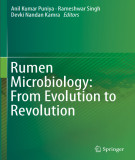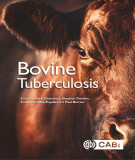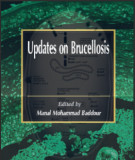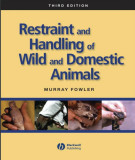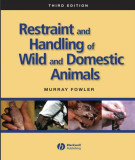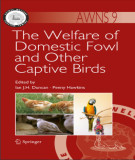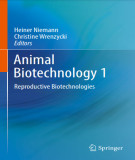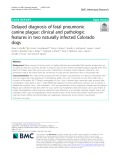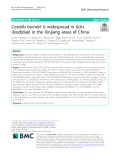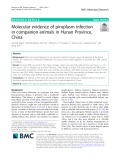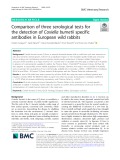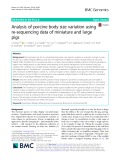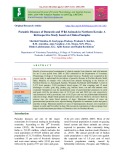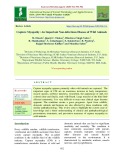
Domestic and wild animals
-
Part 2 book "Humane endpoint and scoring" includes content: Introduction to surgery and suturing, the project licence application, small laboratory animals, genetically modified animals and harmful mutants, carnivores, primates, the larger domestic species, birds, amphibia, wild animals.
 233p
233p  muasambanhan04
muasambanhan04
 11-01-2024
11-01-2024
 5
5
 1
1
 Download
Download
-
Part 1 book "Rumen microbiology - From evolution to revolution" includes content: Rumen microbiology - an overview, rumen microbial ecosystem of domesticated ruminants, domesticated rare animals (yak, mithun and camel) - rumen microbial diversity, wild ruminants, structure and function of a nonruminant gut - a porcine model,... and other contents.
 166p
166p  muasambanhan01
muasambanhan01
 13-12-2023
13-12-2023
 6
6
 3
3
 Download
Download
-
Part 2 book "Bovine tuberculosis" includes content: Molecular virulence mechanisms of mycobacterium bovis; the pathology and pathogenesis of mycobacterium bovis infection; innate immune response in bovine tuberculosis; adaptive immunity; immunological diagnosis; biomarkers in the diagnosis of mycobacterium tuberculosis complex infections; vaccination of domestic and wild animals against tuberculosis; managing bovine tuberculosis - successes and issues; perspectives on global bovine tuberculosis control.
 165p
165p  muasambanhan01
muasambanhan01
 11-12-2023
11-12-2023
 4
4
 2
2
 Download
Download
-
Part 1 book "Updates on brucellosis" includes content: Risk factors for brucella Spp. in domestic and wild animals, brucellosis at the wildlife livestock human interface, the interaction between brucella and the host cell in phagocytosis, brucella induced thrombocytopenia and bleeding, ocular manifestations of brucellosis, neurobrucellosis, brucellosis – granulomatous spine infection.
 111p
111p  oursky09
oursky09
 08-11-2023
08-11-2023
 4
4
 2
2
 Download
Download
-
Part 1 book "Restraint and handling of wild and domestic animals" includes content: Introduction, tools of restraint, rope work, thermoregulation, understanding behavior for restraint purposes, training for restraint procedures, stress, animal welfare concerns during restraint, medical problems during restraint, horses, donkeys, mules, cattle and other domestic bovids, sheep and goats, swine, camelids, dogs, cats, laboratory rodents and rabbits, poultry and waterfowl.
 231p
231p  oursky08
oursky08
 06-11-2023
06-11-2023
 8
8
 5
5
 Download
Download
-
Part 2 book "Restraint and handling of wild and domestic animals" includes content: Delivery systems, chemical restraint, monotremes and marsupials, small mammals, carnivores, nonhuman primates, marine mammals, elephants, other megavertebrates (hoofed stock), hoofed stock (other than the megavertebrates), birds, reptiles, amphibians and fish.
 254p
254p  oursky08
oursky08
 06-11-2023
06-11-2023
 11
11
 4
4
 Download
Download
-
Part 1 book "Animal welfare (Vol09 - The welfare of domestic fowl and other captive birds)" includes content: Introduction, human–bird interactions, the welfare implications of housing captive wild and domesticated birds, training companion birds, the welfare of captive birds in the future.
 141p
141p  oursky06
oursky06
 13-10-2023
13-10-2023
 8
8
 3
3
 Download
Download
-
Grasslands dominate land cover nationally and globally, and their composition, structure and habitat value are strongly influenced by the actions of domestic and wild grazing animals that feed on them. Different pastures are characterised by varying opportunities for selective feeding by livestock; agronomically improved, sown swards generally consist of a limited range of plant species whereas longer-term leys and semi-natural grasslands are characterised by a more diverse mixture of plants.
 21p
21p  vifriedrich
vifriedrich
 25-08-2023
25-08-2023
 2
2
 2
2
 Download
Download
-
Part 1 of ebook "Animal biotechnology 1: Reproductive biotechnologies" presents the following content: the evolution of farm animal biotechnology; future agricultural animals - the need for biotechnology; artificial insemination in domestic and wild animal species; technique and application of sex-sorted sperm in domestic farm animals; embryo transfer technology in cattle; ET-technologies in small ruminants;...
 171p
171p  dieptieuung
dieptieuung
 14-07-2023
14-07-2023
 7
7
 2
2
 Download
Download
-
Animal tuberculosis (TB) is distributed worldwide and has a wide range of wild and domestic reservoirs. Few studies concerning TB in camelids have been published in the last decade, particularly as regards Old World Camelids (OWC), but the increase in reports of TB outbreaks in these species in recent years suggests a high susceptibility to the infection.
 7p
7p  vigandhi
vigandhi
 23-02-2022
23-02-2022
 12
12
 1
1
 Download
Download
-
Plague caused by Yersinia pestis is a highly infectious and potentially fatal zoonotic disease that can be spread by wild and domestic animals. In endemic areas of the northern hemisphere plague typically cycles from March to October, when flea vectors are active. Clinical forms of disease include bubonic, septicemic, and pneumonic plague. All clinical forms are uncommon in dogs and the pneumonic form is exceedingly rare.
 8p
8p  vigandhi
vigandhi
 23-02-2022
23-02-2022
 11
11
 1
1
 Download
Download
-
The gram-negative Coxiella burnetii bacterium is the pathogen that causes Q fever. The bacterium is transmitted to animals via ticks, and manure, air, dead infected animals, etc. and can cause infection in domestic animals, wild animals, and humans.
 9p
9p  vigandhi
vigandhi
 23-02-2022
23-02-2022
 4
4
 1
1
 Download
Download
-
Feline and canine babesiosis is an important tick-borne disease caused by parasites of the genus Babesia. The disease has a worldwide distribution and causes serious health problems in domestic and wild canidae and felidae.
 5p
5p  vigandhi
vigandhi
 23-02-2022
23-02-2022
 10
10
 1
1
 Download
Download
-
Coxiella burnetii causes Q fever, a zoonotic bacterial disease with a multi-host cycle and reservoirs in wild and domestic animal species. Q fever has a significant impact on the Australian public health and economy but its ecology and contributing reservoir species remain poorly understood.
 5p
5p  vigandhi
vigandhi
 23-02-2022
23-02-2022
 8
8
 1
1
 Download
Download
-
A large number of animal species are susceptible to Leishmania infantum (Kinetoplastida, Trypanosomatidae) in endemic areas, including domestic and wild felids such as tigers (Panthera tigris). Knowledge on the infection of this endangered species is still at its infancy, and therefore this study aims to identify clinical presentation and clinicopathological findings of tigers naturally infected by L. infantum.
 7p
7p  vigandhi
vigandhi
 23-02-2022
23-02-2022
 10
10
 1
1
 Download
Download
-
Domestication has led to substantial phenotypic and genetic variation in domestic animals. In pigs, the size of so called minipigs differs by one order of magnitude compared to breeds of large body size. We used biallelic SNPs identified from re-sequencing data to compare various publicly available wild and domestic populations against two minipig breeds to gain better understanding of the genetic background of the extensive body size variation.
 17p
17p  vitzuyu2711
vitzuyu2711
 29-09-2021
29-09-2021
 4
4
 1
1
 Download
Download
-
Coxiella burnetii is a zoonotic pathogen that resides in wild and domesticated animals across the globe and causes a febrile illness, Q fever, in humans. An improved understanding of the genetic diversity of C. burnetii is essential for the development of diagnostics, vaccines and therapeutics, but genotyping data is lacking from many parts of the world.
 17p
17p  visilicon2711
visilicon2711
 20-08-2021
20-08-2021
 9
9
 1
1
 Download
Download
-
In order to assess the prevalence of parasitic diseases in animals in Northern Kerala, a retrospective study based on the data available from the register maintained for recording the results of microscopical examination of clinical samples submitted to the Department of Veterinary Parasitology, College of Veterinary and Animal Sciences, Pookode, Wayanad was conducted during a period from 2005 to 2015 (11 years). The results of the present study on the prevalence of parasitic diseases in Northern Kerala will be helpful for veterinarians and farmers for adopting effective control measures.
 12p
12p  cothumenhmong9
cothumenhmong9
 18-01-2021
18-01-2021
 18
18
 2
2
 Download
Download
-
The papilloma viruses belong to the Papilloma viridae family and new genera were described on the basis of the interspecies phylogenetic similarity. They are DNA viruses that induce the formation of benign and malignant tumors in a vast range of hosts. The main objective of the present study was to detect PV DNA and papilloma virus-associated skin diseases in domestic and wild animals. This paper analyzed nucleotide sequence similarity of animal papilloma virus types to their closest related PV types and HPV sequences deposited in the Gen Bank.
 14p
14p  chauchaungayxua8
chauchaungayxua8
 03-10-2020
03-10-2020
 17
17
 1
1
 Download
Download
-
Capture myopathy appears primarily when wild animals are captured. The important signs of CM are an enormous increase in body temperature, muscle spasms, stiffness lameness, recumbent, the appearance of dark red colored urine and finally, ends with Death. Large muscles of the hind limb affected commonly. It is very difficult to treat once clinical signs become apparent. The condition carries a grave prognosis. Apart from wildlife, domestic animals and humans are also affected by these conditions with similar pathophysiology.
 11p
11p  angicungduoc6
angicungduoc6
 22-07-2020
22-07-2020
 5
5
 1
1
 Download
Download
CHỦ ĐỀ BẠN MUỐN TÌM










